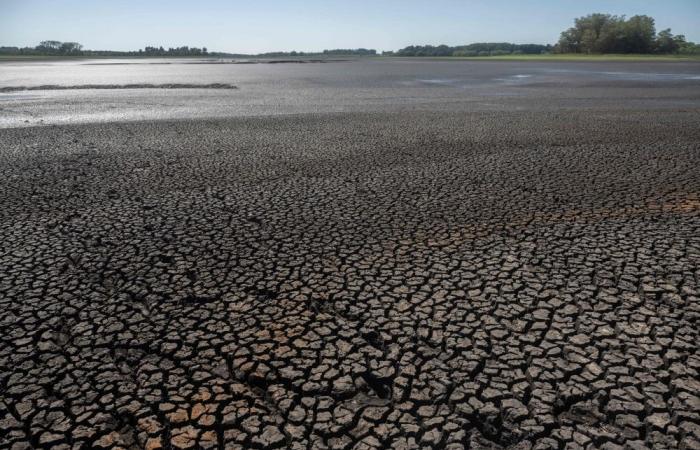Hello and welcome to the details of 2023 hottest recorded year as Earth nears key limit and now with the details

Nevin Al Sukari - Sana'a - A Joshua Tree is seen as the York fire burns in the distance in the Mojave National Preserve on July 30, 2023. The year of 2023 was the hottest on record, with the increase in Earth's surface temperature nearly crossing the critical threshold of 1.5 degrees Celsius, EU climate monitors said on January 9, 2023. — AFP pic
PARIS, Jan 10 — The year of 2023 was the hottest on record, with the increase in Earth’s surface temperature nearly crossing the critical threshold of 1.5 degrees Celsius, EU climate monitors said yesterday.
Climate change intensified heatwaves, droughts and wildfires across the planet, and pushed the global thermometer 1.48 C above the preindustrial benchmark, the Copernicus Climate Change Service (C3S) reported.
“It is also the first year with all days over one degree warmer than the pre-industrial period,” said Samantha Burgess, deputy head of the Copernicus Climate Change Service (C3S).
Advertisement
“Temperatures during 2023 likely exceed those of any period in at least the last 100,000 years.”
Nearly half the year exceeded the 1.5C limit, beyond which climate impacts are more likely to become self-reinforcing and catastrophic, according to scientists.
But even if Earth’s average surface temperature breaches 1.5C in 2024, as some scientists predict, it does not mean the world has failed to meet the Paris Agreement target of capping global warming under that threshold.
Advertisement
That would occur only after several successive years above the 1.5C benchmark, and even then the 2015 treaty allows for the possibility of reducing Earth’s temperature after a period of “overshoot”.
2023 saw massive fires in Canada, extreme droughts in the Horn of Africa or the Middle East, unprecedented summer heatwaves in Europe, the United States and China, along with record winter warmth in Australia and South America.
“Such events will continue to get worse until we transition away from fossil fuels and reach net-zero emissions,” said University of Reading climate change professor Ed Hawkins, who did not contribute to the report.
“We will continue to suffer the consequences of our inactions today for generations.”
The Copernicus findings come one month after a climate agreement was reached at COP28 in Dubai calling for the gradual transition away from fossil fuels, the main cause of climate warming.
“We desperately need to rapidly cut fossil fuel use and reach net-zero to preserve the liveable climate that we all depend on,” said John Marsham, atmospheric science professor at the University of Leeds.
The year saw another ominous record: two days in November 2023 exceeded the preindustrial benchmark by more than two degrees Celsius.
Copernicus predicted that the 12-month period ending in January or February 2024 would “exceed 1.5 degrees Celsius above the pre-industrial level”.

Picture of the dried Canelon Grande reservoir just north of Canelones, in southern Uruguay, taken on March 14, 2023, as the country goes through a severe drought. — AFP pic
Oceans in overdrive
Reliable weather records date back to 1850, but older proxy data for climate change — from tree rings, ice cores and sediment — show that 2023 temperatures “exceed those of any period in at least the last 100,000 years”, Burgess said.
Records were broken on every continent. In Europe, 2023 was the second-warmest year on record, at 0.17°C cooler than 2020.
2023 saw the beginning of a naturally occurring El Nino weather phenomenon, which warms waters in the southern Pacific and stokes hotter weather beyond.
The phenomenon is expected to reach its peak in 2024, and is linked to the eight consecutive months of record heat from June to December.
Ocean temperatures globally were also “persistently and unusually high”, with many seasonal records broken since April.

A billboard displays a temperature of 118 degrees Fahrenheit (48 degrees Celcius) during a record heat wave in Phoenix, Arizona July 18, 2023. — AFP pic
Soaring CO2 and methane
These unprecedented ocean temperatures caused marine heatwaves devastating to aquatic life and boosted the intensity of storms.
Oceans absorb more than 90 per cent of excess heat caused by human activity, and play a major role in regulating Earth’s climate.
Rising temperatures have also accelerated the melting of ice shelves — frozen ridges that help prevent massive glaciers in Greenland and West Antarctica from slipping into the ocean and raising sea levels.
Antarctic sea ice hit record-low levels in 2023.
“The extremes we have observed over the last few months provide a dramatic testimony of how far we now are from the climate in which our civilisation developed”, said Carlo Buontempo, C3S director.
In 2023, carbon dioxide and methane concentrations reached record levels of 419 parts per million, and 1,902 parts per billion, respectively.
Methane is the second largest contributor to global warming after CO2, and is responsible for around 30 per cent of the rise in global temperatures since the industrial revolution, according to the United Nations Environment Programme (UNEP). — AFP
These were the details of the news 2023 hottest recorded year as Earth nears key limit for this day. We hope that we have succeeded by giving you the full details and information. To follow all our news, you can subscribe to the alerts system or to one of our different systems to provide you with all that is new.
It is also worth noting that the original news has been published and is available at Malay Mail and the editorial team at AlKhaleej Today has confirmed it and it has been modified, and it may have been completely transferred or quoted from it and you can read and follow this news from its main source.



